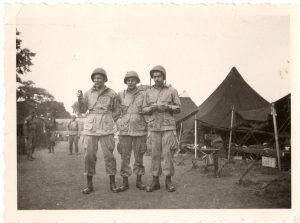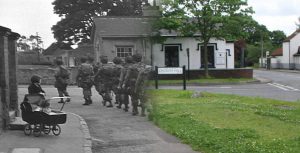When one looks back at the rich history of the US Airborne, the period that stands out the most, to many, is their proud achievements during the Second World War. Of course, that’s where the Airborne story begins, and the men involved were the fathers of what has become a much loved and trusted branch of the US Armed Forces.
by Adam Berry – Author of And Suddenly They Were Gone

Jackson M Floyd, Joseph Lobos and Edward C Jablonski of E.Company, 508th PIR, stand in their Company Street at Camp Wollaton, Nottingham, home of the 508th PIR from March to September, 1944.
Those brave boys of the 2nd Battalion, 503rd PIR (Later to be re-designated as the 509th Parachute Infantry Battalion) who parachuted into North Africa way back in November, 1942, having suffered an arduous flight riding the steel benches of a C-47 all the way from England, kicked open a metaphorical door through which stormed some of Americas most decorated soldiers, Airborne warriors, tough paratroopers, and Generals who were most at home fighting from the Foxholes among their men. Followed by the 82nd Airborne Division into Sicily, and Italy, as the boys of the 11th Airborne Division prepared to fight the Japanese in the Pacific, the 509th PIB initiated the very first etchings of the Airborne story onto the slate.
These histories can be found in abundance, in any Library or bookshop, wherever you turn. The combat history of each Division, or each independent Battalion or Regiment, can be found with ease. Many cover the same stories, many talk of the same men, and as time marches by it becomes harder and harder to add to those histories something that people have not already read before. But why not consider the time spent out of the combat zone?
Sure, there’s plenty to be read of the training regimes undertaken in the States. The meteoric levels of physical fitness obtained, and the super dangerous parachute training that cost so many a broken bone or two – or their lives, but there’s more to it than that.
Even those early Airborne soldiers of the 509th PIB, the first to see the enemy through the sights of an M1 Rifle, trained for their Operation from campsites in England. The 101st, 82nd, and 17th Airborne Divisions all had campsites in England leading up to combat Operations in mainland Europe, and were afforded the opportunity to train in terrain almost identical to that they would face in France, Holland, Belgium, Germany, Italy, Czechoslovakia, and beyond. But again, there’s more to it than that. I often refer to those from the Airborne Divisions as “boys” because, let’s face it, that’s what they were. Bob Murphy, a Pathfinder with A Company, 505th PIR, was just 17 years old when he first faced an enemy soldier. I write this as a 29 year old with no military background, but I find it incomprehensible to think about doing the same at the age of 17. What were most males doing at 17? Chasing girls, playing Football, doing homework for High School, cleaning their new car? It’s fair to assume that the combat in Sicily and Italy made Bob Murphy grow up, and fast, but when he reached England with his Regiment, and found his campsite to be located in the quaint Leicestershire village of Quorn he was, after all, still only 18 years old and that adolescent excitement was still ripe in him.







